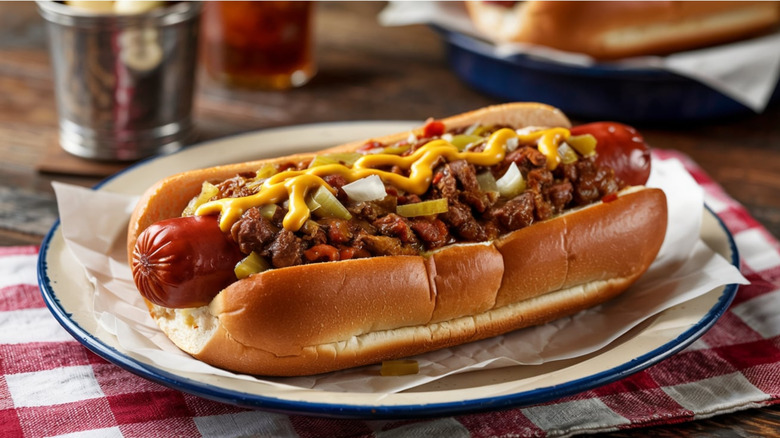The Popular 70s Hot Dog Chain You'll Never Eat At Again
The American appetite for all-beef hot dogs is one of the longest-lasting. According to the National Hot Dog and Sausage Council, franks made up an astonishing $3 billion market in 2024. This is a short portion of the total fast food market, which has been growing rapidly in the 21st century. Even with these high sales, one American retailer that was once a staple across the southern United States has faded out of the market. For generations, Lum's was ready to take on the likes of McDonald's with its cost-effective and diverse menu. But today, the hot dog giant is a cautionary tale of the effect of management and corporate oversight on longevity.
Born in 1956, Lum's was fostered from a mom and pop shop to a legitimate chain by brothers Stuart and Clifford Perlman. On the boardwalks of Miami Beach, the brothers slowly grew their business into a national chain with upwards of 400 locations nationwide. Unlike the modern cooking style of having dogs slowly rolling under heat lamps, Lum's touted beer-steamed dogs, deeper in flavor and quicker to cook. Speaking with the Democrat & Chronicle, one patron described Lum's at its height as "a far classier place than McDonald's or the Red Barn, a place teens could afford that actually had a menu." Even with these heights, the fall of Lum's was fast, with a majority of their locations shuttering their doors by the 1980s.
How ownership and a change in hot dog sales sunk Lum's
Lum's abrupt fall is due to two major factors: the departure of the Perlman brothers in the early 1970s and a change in where Americans bought their hot dogs. Building off Lum's success, the brothers purchased a casino in 1969, now known as Caesars Palace. This move was lucrative for the Perlman brothers, as Caesars Palace became a massive revenue draw and continues to help drive the boom of sports gambling in states across the country. In fact, Clifford Perlman might be better known for his time as the CEO of Caesars Palace than for his contributions to Lum's. The brothers ultimately sold Lum's Inc. in 1971 to the former chairman of Kentucky Fried Chicken, John Y. Brown. While Brown attempted to innovate with creations like the Ollieburger, the company filed for bankruptcy just over ten years after he purchased it.
The Democrat & Chronicle reports Brown's business practices were questionable, and while he did pay $1 million for the Ollieburger's secret recipe, that wasn't the only reason the company ultimately failed. Americans as a whole began focusing their appetite for franks on the ballpark, where hot dogs can be sold at astronomical rates any chain would struggle to keep up with. Even so, America's appetite for Lum's is still alive. The company remains active online as a wholesaler and pop-up shop, though the days of eating in an iconic Lum's restaurant are still long gone.

